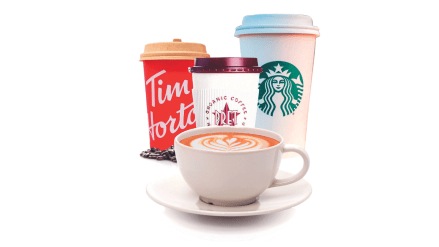This month, the Indian subsidiary of the world’s largest coffeehouse chain Starbucks rolled out smaller “Picco” sized versions of some of its hot drinks in the country, making its prices more affordable at an entry point of 185. It also rolled out a line of bite-sized snacks. While the company refused to participate in the story, the store manager of a popular Noida-based outlet claimed that his store was selling 15-20 more cups of coffee a day as a result of the move. The competition from other chains was fierce, he noted. For context, the Indian coffee retail chain market is currently about Rs 4500 crore and is growing at a rate of 8-9%. Starbucks (340 stores), Cafe Coffee Day (470+), Tim Hortons (17), Barista (360+), Costa Coffee (100+), and Third Wave Coffee (90+) are some of the top players. Recently, Reliance also forayed into the segment, bringing UK-based Pret A Manger to India.
Experts say the sector can grow on the back of rising disposable incomes, increasing purchasing power, urbanisation and the growing popularity of coffee among the young population. Expansion into tier-2 and tier-3 cities will also aid the segment, they added.
Two factors — aspiration and experience — are key drivers of growth. First, coffee-based beverages that the typical Indian consumer drinks are mostly items such as cappuccinos and lattes, which are difficult to prepare at home. Therefore, they are willing to pay higher prices. This is aspirational. Angshuman Bhattacharya, partner and national leader, consumer products and retail, EY, elaborates on the second aspect, “The cafe concept is less about coffee but more about the experience. It is about trying varieties at a place where people meet to interact.” As more malls and markets crop up, the occasions for visiting such outlets also increase.
Challenges ahead
Back in 2012, when retail coffee chain Starbucks marked its debut in India, it was met with a long line of customers waiting to try its wide range of drinks and snacks outside its stores. Enthusiastic first-timers, who had only heard about the brand from peers abroad, clicked photos of personalised coffee cups with their names to post on social media.
“Since then, competition in the retail coffee sector chain in India has only toughened with the entry of other big global players. While pricing has become very important, there is ample room for growth,” said Pramod Damodaran, CEO, Wagh Bakri Tea Lounge.
That is what coffee chains are banking on. Said Tarun Jain, CEO, Tim Hortons India, “We have ambitious plans for growth in India. We plan to open 120 stores in three years, across key cities in the country. We will focus on areas with high footfall, such as malls, high streets, and airports. We will also target areas with a growing middle class, who are looking for international experiences.”
A veteran in the game, Barista, meanwhile, is aiming to grow to 500+ stores in the next two years. “There is an upsurge in demand, which is why there is space for everyone to take a certain market share. The most agile would conquer the maximum. We have already penetrated non-metros as well,” said CEO Rajat Agrawal.
That said, these chains are also dealing with their own set of issues.
First, while premium price points might work to some extent in metro cities, they might need to be brought down in other geographies if brands do not build enough value, say experts. This is because Indian consumers are usually price-sensitive. However, since the country is not a mature coffee market, customers may be willing to pay a premium for the beverage, provided the brand’s perceived value is good. Therefore, positioning is key.
Second, the sector cannot earn much via delivery as coffee is meant to be consumed while it’s still hot. “Lead times of food delivery players are close to 40 minutes per delivery. QSRs such as McDonald’s, KFC, and Jubilant are all driving close to 40-60% of their revenue from delivery. But coffee chains function more like a fine dining restaurant, with only about 15% of the revenue coming from delivery. That will always be a laggard,” said Karan Taurani, senior vice-president at Elara Capital.
Ticket sizes are also very small when compared to QSR chains and fine dining restaurants. Moreover, table turnovers are very low for coffee chains as people stay for a long time at a coffee shop.
Other concerns include being able to acquire real estate to open outlets in prime spaces along with pricey rental costs. Coffee chains also usually have high manpower costs as a number of people are involved in translating the experience to the consumer. Since operating expenses are high, chains must also have a certain sales volume to be able to run a store, say experts.
Finally, a huge part of the coffee retail segment is fragmented, comprising small cafes, some of them providing artisanal coffee. These are appealing to a large Gen Z crowd. Says Ravi Choudhary, head chef of Hyderabad-based Fornai Caffe, “There is charm in the artisanal coffee experience. Smaller coffee stores offer craftsmanship, authenticity, and connection that larger chains simply struggle to replicate.”
